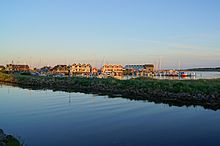Djursland
Djursland protrudes into the Kattegat sea, as part of the larger peninsula of Jutland, which itself extends from the Central European continent.
There are many prehistoric relics of the past on Djursland, reaching back to the earliest cultures of the Nordic Stone Age.
It attracts both Danes and foreigners alike and tourism is a major job and economic contributor on Djursland nowadays.
Since 2009, a larger area of Djursland has been part of Mols Bjerge National Park, connecting several previously disconnected protections.
[1] A little over 10% of Djursland is covered with forest (plantations) and the most common trees are Norway spruce, Scots pine and beech.
As in the rest of Denmark, excluding the remote island of Bornholm, there is no surface bedrock - neither above nor below the sea -, as Djursland's landscapes were formed by complex and non-uniform glacial movements with related meltwater flows, in the span of the last three ice ages.
The northern side of the sound is flanked by 25 km of border hills down to the lakebed contributing to the characteristics of the landscape.
This is done by grazing and cutting down excessive tree growth that would otherwise cause natural, and dense, forestation, obstructing views and accessibility.
The land bordering Randers Fjord is in some places marshy plains covered in reeds, which to some extent are cut and used for traditional thatching of house roofs.
In recent years, ravens have become more widespread, just as some species of large birds of prey that had not bred here for many decades, such as kites, have reinhabited Djursland.
Tourism in the Ebeltoft area is in part based on a picturesque historical and rural town centre, and the hilly coastal landscapes of Mols with accessible coastline and beaches with many bights and inlets.
Ebeltoft is connected by ferry to Zealand, the eastern main island of Denmark on which the capital, Copenhagen (pop.
[3] Smaller towns in Djursland with shopping centres include Rønde, Hornslet, Auning, Mørke, Ryomgård, Kolind, Allingåbro, Fjellerup Strand, Pindstrup and Glesborg.
The low population density of 51 inhabitants per km2, as compared to Germany's 230 and England's 410, is a contributing factor in making Djursland attractive for visitors.
Another factor is climate: Djursland is less rainy than England, and rarely suffers from the sweltering summer heat that can be a challenge in Mediterranean coastal regions.
There is a distribution of marinas along the coasts of Djursland and nearby shores, generating a well-developed yacht tourism in the summer.







